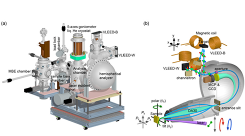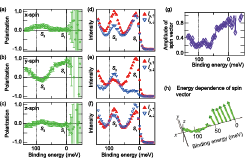High-Resolution Three-Dimensional Spin- and Angle-Resolved Photoelectron Spectrometer Using Vacuum Ultraviolet Laser Light
Komori and Shin Groups
Spin-polarized electrons in solids have been intensively studied not only for fundamental scientific interests but also for technological applications such as to spintronic devices utilizing the spin degree of freedom. Recently, highly spin-polarized surface states have been discovered under the topological concepts associated with the electronic band structure of materials with strong spin-orbit interaction. Spin- and angle-resolved photoelectron spectroscopy (SARPES) is a powerful technique for investigating such spin-dependent electronic bands. We have constructed a SARPES apparatus [1] with high energy (1.7 meV) and angle resolutions (0.7˚) by combining a very-low-energy-electron-diffraction-type (VLEED) spin detector using the oxygen-adsorbed Fe surface [2] and a high-photon-flux vacuum-ultraviolet (VUV) laser, the 6th harmonic of a basic wave of Nd:YVO4 quasi-continuous wave laser with a non-linear optical crystal KBe2BOF2. (hν = 6.994 eV) [3]. The spectrometer consists of a hemispherical photoelectron analyzer equipped with a photoelectron deflector function and twin VLEED detectors, as shown in Fig. 1. The latter allows us to analyze the spin vector of a photoelectron three-dimensionally.

Fig. 1. (a) Overview of the laser-SARPES system developed at the Laser and Synchrotron Research Laboratory. [1] (b) Schematic drawing of the photoelectron detection part of laser-SARPES. The angle between the laser and the analyzer is fixed at 50˚. Twin VLEED spin detectors arranged with orthogonal geometry are connected to the hemispherical photoelectron analyzer. The spectrometer is also equipped with electron deflectors at the multi-electron-lens part between the sample and the entrance slit.

Fig. 2. Spin-polarized surface bands at a point between Γ and K on the Bi(111) surface detected by the three-dimensional laser-SARPES. (a-f) The x (a,d), y (b,e) and z (c,f) components of the spin polarization and the spin-resolved spectra. (g) Amplitude of the spin vector of the photoelectron emitted with the present experimental geometry shown in Fig. 1b. (h) Schematic drawing of the spin vector of the photoelectron emitted from the point between Γ and K as a function of the binding energy. The length of the arrows is proportional to the amplitude of the spin vector.
We have shown that the present laser-SARPES machine realizes a quick SARPES on the spin-split surface band structure of a Bi(111) film even with 7 meV energy and 0.7˚ angular resolutions. Figure 2 demonstrates three-dimensional detection of the spin polarization on the Bi(111) surface. We performed three-dimensional SARPES at a point between Γ and K where we can expect non-zero spin polarizations in the x, y, and z directions because of the absence of mirror symmetry on the ΓK line of the Bi(111) surface. In Figs. 2(a)-(f), two spin-polarized surface states, labeled S1 and S2, are clearly seen, and the amplitude of the spin vector is summarized in Fig. 2(g). From the spin polarization analysis, we can draw the energy dependence of the spin vector as in Fig. 2(h).
References
- [1] K. Yaji et al., Rev. Sci. Instrum. 87, 053111 (2016).
- [2] T. Okuda et al., Rev. Sci. Instrum. 82, 103302 (2011).
- [3] T. Kiss et al., Rev. Sci. Instrum. 73, 1875 (2002).
